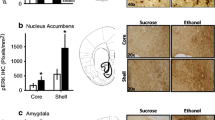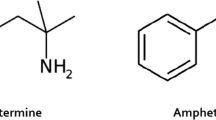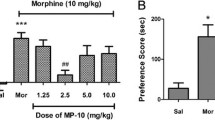Abstract
Rationale
Previous studies indicate that the rewarding effect of D-1 dopamine receptor stimulation in nucleus accumbens (NAc) shell is greater in food-restricted (FR) than in ad libitum fed (AL) rats. The D-1 receptor is positively coupled to adenylyl cyclase and activates protein kinase A (PKA).
Objectives
The purpose of this study was to determine whether PKA is involved in the rewarding effect of D-1 receptor stimulation and, if so, whether it is involved in the enhanced response of FR rats.
Materials and methods
Rats were stereotaxically implanted with microinjection cannulae in NAc shell and a stimulating electrode in lateral hypothalamus. The rewarding effects of SKF-82958 (1.5 or 3.0 μg, bilaterally) in the presence and absence of PKA inhibitor, Rp-cAMPS (8.9 μg), and PKA activator, Sp-cAMPS (8.9 μg), were assessed using the curve-shift method of intracranial self-stimulation (ICSS). Basal NAc levels of DARPP-32 phosphorylated on Thr34 and Thr75 were measured.
Results
Rp-cAMPS increased the rewarding effect of SKF-82958 in AL but not FR rats, doubling the ICSS threshold-lowering effect of the 3.0-μg dose. Sp-cAMPS decreased the rewarding effect of SKF-82958 in FR but not AL rats. Levels of phospho-DARPP-32 (Thr75), which inhibits PKA, were higher in FR than AL rats.
Conclusions
Results indicate that inhibition of PKA enhances the unconditioned rewarding effect of D-1 receptor stimulation and that decreased PKA may be involved in the effect of FR on drug reward. Evidence for involvement of D-2 receptor-expressing neurons in the enhancing effect of PKA inhibition is discussed.






Similar content being viewed by others
References
Baladi MG, France CP (2009) High fat diet and food restriction differentially modify the behavioral effects of quinpirole and raclopride in rats. Eur J Pharmacol 610:55–60
Baldwin AE, Sadeghian K, Holahan MR, Kelley AE (2002) Appetitive instrumental learning is impaired by inhibition of cAMP-dependent protein kinase within the nucleus accumbens. Neurobiol Learn Mem 77:44–62
Bateup HS, Svenningsson P, Kuroiwa M, Gong S, Nishi A, Heintz N, Greengard P (2008) Cell type-specific regulation of DARPP-32 phosphorylation by psychostimulant and antipsychotic drugs. Nat Neurosci 11:932–939
Beninger RJ, Gerdjikov T (2004) The role of signaling molecules in reward-related incentive learning. Neurotox Res 6:91–104
Bibb JA, Chen J, Taylor JR, Svenningsson P, Nishi A, Snyder GL, Yan Z, Sagawa ZK, Ouimet CC, Nairn AC, Nestler EJ, Greengard P (2001) Effects of chronic exposure to cocaine are regulated by the neuronal protein Cdk5. Nature 410:376–380
Cabeza de Vaca S, Kannan P, Pan Y, Jiang N, Sun Y, Carr KD (2007) The adenosine A2a receptor agonist, CGS-21680, blocks excessive rearing, acquisition of wheel running, and increases nucleus accumbens CREB phosphorylation in chronically food-restricted rats. Brain Res 1142:100–109
Carr KD (2007) Food restriction: enhancing effects on drug reward and striatal cell signaling. Physiol Behav 91:459–472
Carr KD, Kim G-Y, Cabeza de Vaca S (2001) Rewarding and locomotor-activating effects of direct dopamine receptor agonists are augmented by chronic food restriction in rats. Psychopharmacol 154:420–428
Carr KD, Tsimberg Y, Berman Y, Yamamoto N (2003) Evidence of increased dopamine receptor signaling in food-restricted rats. Neurosci 119:1157–1167
Carr KD, Cabeza de Vaca S, Sun Y, Chau LS (2009) Reward-potentiating effects of D-1 dopamine receptor agonist and AMPAR GluR1 antagonist in nucleus accumbens shell and their modulation by food restriction. Psychopharmacol 202:731–743
Carr KD, Chau LS, Cabeza de Vaca S, Gustafson K, Stouffer M, Tukey D, Restituito S, Ziff E (2010) AMPA receptor subunit GluR1 downstream of D-1 dopamine receptor stimulation in nucleus accumbens shell mediates increased drug reward magnitude in food-restricted rats. Neurosci 165:1074–1086
Cepeda C, Buchwald NA, Levine MS (1993) Neuromodulatory actions of dopamine in the neostriatum are dependent upon the excitatory amino acid receptor subtypes activated. Proc Natl Acad Sci USA 90:9576–9580
Cochrane C, Malcolm R, Brewerton T (1998) The role of weight control as a motivation for cocaine abuse. Addict Behav 23:201–207
Collins GT, Calinski DM, Newman AH, Grundt P, Woods JH (2008) Food restriction alters N′-propyl-4,5,6,7-tetrahydrobenzothiazole-2,6-diamine dihydrochloride (pramipexole)-induced yawning, hypothermia, and locomotor activity in rats: evidence for sensitization of dopamine D2 receptor-mediated effects. J Pharmacol Exp Ther 325:691–697
Dalley JW, Laane K, Theobald DEH, Armstrong HC, Corlett PR, Chudasama Y, Robbins TW (2005) Time-limited modulation of appetitive Pavlovian memory by D1 and NMDA receptors in the nucleus accumbens. Proc Natl Acad Sci 102:6189–6194
Diaz-Cabiale Z, Hurd Y, Guidolin D, Finnman U-B, Zoli M, Agnati LF, Vanderhaeghen J-J, Fuxe K, Ferre S (2001) Adenosine A2A agonist CGS 21680 decreases the affinity of dopamine D2 receptors for dopamine in human striatum. Neuroreport 12:1831–1834
Dunah AW, Sirianni AC, Fienberg AA, Bastia E, Schwarzschild MA, Standaert DG (2004) Dopamine D1-dependent trafficking of striatal N-methyl-D-aspartate glutamate receptors requires Fyn protein tyrosine kinase but not DARPP-32. Mol Pharmacol 65:121–129
Fernandez E, Schiappa R, Girault J-A, Le Novere N (2006) DARPP-32 is a robust integrator of dopamine and glutamate signals. PloS Comp Biol 2:1619–1633
Fiorentini C, Gardoni F, Spano P, Di Luca M, Missale C (2003) Regulation of dopamine D1 receptor trafficking and desensitization by oligomerization with glutamate N-methyl-D-aspartate receptors. J Biol Chem 278:20196–20202
Fuxe K, Agnati LF, Jacobsen K, Hillion J, Canals M, Torvinen M, Tinner-Staines B, Staines W, Rosin D, Terasmaa A, Popoli P, Leo G, Vergoni V, Lluis C, Ciruela F, Franco R, Ferre S (2003) Receptor heteromerization in adenosine A2A receptor signaling: relevance for striatal function and Parkinson's disease. Neurol 61:S19–S23
Gerdjikov TV, Giles AC, Swain SN, Beninger RJ (2007) Nucleus accumbens PKA inhibition blocks acquisition but enhances expression of amphetamine-produced conditioned activity in rats. Psychopharmacol 190:65–72
Gerfen CR, Surmeier DJ (2011) Modulation of striatal projection systems by dopamine. Ann Rev Neurosci 34:441–466
Groenewegen HJ, Wright CI, Beijer AV, Voorn P (1999) Convergence and segregation of ventral striatal inputs and outputs. Ann NY Acad Sci 877:49–63
Haberny SL, Carr KD (2005a) Comparison of basal and D-1 dopamine receptor agonist-stimulated neuropeptide gene expression in caudate-putamen and nucleus accumbens of ad libitum fed and food-restricted rats. Molec Brain Res 141:121–127
Haberny SL, Carr KD (2005b) Food restriction increases NMDA receptor-mediated CaMK II and NMDA receptor/ERK 1/2-mediated CREB phosphorylation in nucleus accumbens upon D-1 dopamine receptor stimulation in rats. Neurosci 132:1035–1043
Haberny S, Berman Y, Meller E, Carr KD (2004) Chronic food restriction increases D-1 dopamine receptor agonist-induced ERK1/2 MAP kinase and CREB phosphorylation in caudate-putamen and nucleus accumbens. Neurosci 125:289–298
Hakansson K, Galdi S, Hendrick J, Snyder G, Greengard P, Fisone G (2006) Regulation of phosphorylation of the GluR1 AMPA receptor by dopamine D2 receptors. J Neurochem 96:482–488
Hallett PJ, Spoelgen R, Hyman BT, Standaert DG, Dunah AW (2006) Dopamine D1 activation potentiates striatal NMDA receptors by tyrosine phosphorylation-dependent subunit trafficking. J Neurosci 26:4690–4700
Hillion J, Canals M, Torvinen M, Cadado V, Scott R, Terasmaa A, Hansson A, Watson S, Olah ME, Mallol J, Canela EI, Zoli M, Agnati LF, Ibanez CF, Lluis C, Franco R, Ferre S, Fuxe K (2002) Coaggregation, cointernalization and codesensitization of adenosine A2A receptors and dopamine D2 receptors. J Biol Chem 277:18091–18097
Hsu CW, Chen CY, Wang C-S, Chiu TH (2009) Caffeine and a selective adenosine A2A receptor antagonist induce reward and sensitization behavior associated with increased phospho-Thr75-DARPP-32 in mice. Psychopharmacol 204:313–325
Hyman SE, Malenka RC, Nestler EJ (2006) Neural mechanisms of addiction: the role of reward-related learning and memory. Ann Rev Neurosci 29:565–598
Ikemoto S (2007) Dopamine reward circuitry: two projection systems from the ventral midbrain to the nucleus accumbens-olfactory tubercle complex. Brain Res Rev 56:27–78
Ikemoto S, Glazier BS, Murphy JM, McBride WJ (1997) Role of dopamine D1 and D2 receptors in the nucleus accumbens in mediating reward. J Neurosci 17:8580–8587
Kelley AE (2004) Ventral striatal control of appetitive motivation: role in ingestive behavior and reward-related learning. Neurosci Biobehav Rev 27:765–776
Kheirbek MA, Beeler JA, Ishikawa Y, Zhuang X (2008) A cAMP pathway underlying reward prediction in associative learning. J Neurosci 28:11401–11408
Klesges RC, Elliott VE, Robinson LA (1997) Chronic dieting and the belief that smoking controls body weight in a biracial, population-based adolescent sample. Tob Control 6:89–94
LaHoste GJ, Henry BL, Marshall JF (2000) Dopamine D1 receptors synergize with D2, but not D3 or D4, receptors in the striatum without the involvement of action potentials. J Neurosci 20:6666–6671
Lee AM, Messing RO (2008) Protein kinases and addiction. Ann NY Acad Sci 1141:22–57
Lee FJ, Xue S, Pei L, Vukusic B, Chery N, Wang Y, Wang YT, Niznik HB, Yu XM, Liu F (2002) Dual regulation of NMDA receptor functions by direct protein-protein interactions with the dopamine D1 receptor. Cell 111:219–230
Lobo MK, Covington HE 3rd, Chaudhury D, Friedman AK, Sun H, Damez-Werno D, Dietz DM, Zaman S, Koo JW, Kennedy PJ, Mouzon E, Mogri M, Neve RL, Deisseroth K, Han MH, Nestler EJ (2010) Cell type-specific loss of BDNF signaling mimics optogenetic control of cocaine reward. Science 330:385–390
Lynch WH, Taylor JR (2005) Persistent changes in motivation to self-administer cocaine following modulation of cyclic AMP-dependent protein kinase A (PKA) activity in the nucleus accumbens. Eur J Neurosci 22:1214–1220
Malenka RC, Bear MF (2004) LTP and LTD: an embarrassment of riches. Neuron 44:5–21
Mannoury La Cour C, Vidal S, Pasteau V, Cussac D, Millan MJ (2007) Dopamine D1 receptor coupling to Gs/olf and Gq in rat striatum and cortex: a scintillation proximity assay (SPA)/antibody-capture characterization of benzazepine agonists. Neuropharmacol 52:1003–1014
Miliaressis E, Rompre PP, Laviolette P, Philippe L, Coulombe D (1986) The curve-shift paradigm in self-stimulation. Physiol Behav 37:85–91
Missale C, Nash SR, Robinson SW, Jaber M, Caron MG (1998) Dopamine receptors: from structure to function. Physiol Rev 78:189–225
O’Donnell P, Grace AA (1993) Physiological and morphological properties of accumbens core and shell neurons recorded in vitro. Synapse 13:135–160
Perez MF, White FJ, Hu XT (2006) Dopamine D(2) receptor modulation of K(+) channel activity regulates excitability of nucleus accumbens neurons at different membrane potentials. J Neurophysiol 96:2217–2228
Pisetsky EM, Chao YM, Dierker LC, May AM, Striegel-Moore RH (2008) Disordered eating and substance use in high-school students: results from the Youth Risk Behavior Surveillance System. Int J Eat Disord 41:464–470
Podda MV, Riccardi E, D'Ascenzo M, Azzena GB, Grassi C (2010) Dopamine D1-like receptor activation depolarizes medium spiny neurons of the mouse nucleus accumbens by inhibiting inwardly rectifying K + currents through a cAMP-dependent protein kinase A-independent mechanism. Neurosci 167:678–690
Root TL, Pinheiro AP, Thornton L, Strober M, Fernandez-Aranda F, Brandt H, Crawford S, Fichter MM, Halmi KA, Johnson C, Kaplan AS, Klump KL, La Via M, Mitchell J, Woodside DB, Rotondo A, Berrettini WH, Kaye WH, Bulik CM (2010) Substance use disorders in women with anorexia nervosa. Int J Eat Disord 43:14–21
Self DW, Genova LM, Hope BT, Barnhart WJ, Spencer JJ, Nestler EJ (1998) Involvement of cAMP-dependent protein kinase in the nucleus accumbens in cocaine self-administration and relapse of cocaine-seeking behavior. J Neurosci 18:1848–1859
Shuen JA, Chen M, Gloss B, Calakos N (2008) Drd1a-tdTomato BAC transgenic mice for simultaneous visualization of medium spiny neurons in the direct and indirect pathways of the basal ganglia. J Neurosci 28:2681–2685
Snyder GL, Allen PB, Fienberg AA, Valle CG, Huganir RL, Nairn AC, Greengard P (2000) Regulation of phosphorylation of the GluR1 AMPA receptor in the neostriatum by dopamine and psychostimulants in vivo. J Neurosci 20:4480–4488
Stamp JA, Mashoodh R, van Kampen JM, Robertson HA (2008) Food restriction enhances peak corticosterone levels, cocaine-induced locomotor activity, and DeltaFosB expression in the nucleus accumbens of the rat. Brain Res 1204:94–101
Stoof JC, Kebabian JW (1982) Independent in vitro regulation by the D-2 dopamine receptor of dopamine-stimulated efflux of cyclic AMP and K+-stimulated release of acetylcholine from rat neostriatum. Brain Res 250:263–270
Sun X, Zhao Y, Wolf ME (2005) Dopamine receptor stimulation modulates AMPA receptor synaptic insertion in prefrontal cortex neurons. J Neurosci 25:7342–7351
Surmeier DJ, Bargas J, Hemmings HC Jr, Nairn AC, Greengard P (1995) Modulation of calcium currents by a D1 dopaminergic protein kinase/phosphatase cascade in rat neostriatal neurons. Neuron 14:385–397
Svenningsson P, Lindskog M, Rognoni F, Fredholm BB, Greengard P, Fisone G (1998) Activation of adenosine A2A and Dopamine D1 receptors stimulates cyclic AMP-dependent phosphorylation of DARPP-32 in distinct populations of striatal projection neurons. Neurosci 84:223–228
Svenningsson P, Nishi A, Fisone G, Girault J-A, Nairn AC, Greengard P (2004) DARPP-32: an integrator of neurotransmission. Annu Rev Pharmacol Toxicol 44:269–296
Terwilliger RZ, Beitner-Johnson D, Sevarino KA, Crain SM, Nestler EJ (1991) A general role for adaptations in G-proteins and the cyclic AMP system in mediating the chronic actions of morphine and cocaine on neuronal function. Brain Res 548:100–110
Unterwald EM, Fillmore J, Kreek MJ (1996) Chronic repeated cocaine administration increases dopamine D1 receptor-mediated signal transduction. Eur J Pharmacol 318:31–35
Wachtel SR, Hu XT, Galloway MP, White FJ (1989) D1 dopamine receptor stimulation enables the postsynaptic, but not autoreceptor, effects of D2 dopamine agonists in nigrostriatal and mesoaccumbens dopamine systems. Synapse 4:327–346
Walaas SI, Hemmings HC Jr, Greengard P, Nairn AC (2011) Beyond the dopamine receptor: regulation and roles of serine/threonine protein phosphatases. Front Neuroanat 5:1–17
Wang JQ, Liu X, Zhang G, Parelkar NK, Arora A, Haines M, Fibuch EE, Mao L (2006) Phosphorylation of glutamate receptors: A potential mechanism for the regulation of receptor function and psychostimulant action. J Neurosci Res 84:1621–1629
Wiederman MW, Pryor T (1996) Substance abuse and impulsive behaviors among adolescents with eating disorders. Addict Behav 21:269–272
Wise RA (1996) Addictive drugs and brain stimulation reward. Ann Rev Neurosci 19:319–340
Acknowledgments
This research was supported by DA003956 and DA007254 from NIDA/NIH.
Author information
Authors and Affiliations
Corresponding author
Rights and permissions
About this article
Cite this article
de Vaca, S.C., Peng, XX., Concors, S. et al. Effects of protein kinase A inhibitor and activator on rewarding effects of SKF-82958 microinjected into nucleus accumbens shell of ad libitum fed and food-restricted rats. Psychopharmacology 221, 589–599 (2012). https://doi.org/10.1007/s00213-011-2602-z
Received:
Accepted:
Published:
Issue Date:
DOI: https://doi.org/10.1007/s00213-011-2602-z




